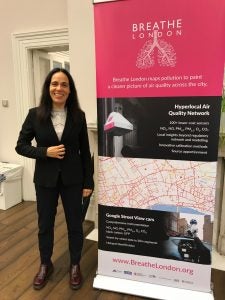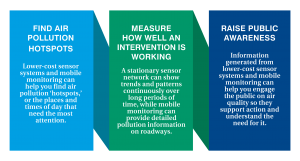 A key question for any city considering using lower-cost sensors or mobile monitoring to measure air pollution is, “Can they provide reliable data and insights?”
A key question for any city considering using lower-cost sensors or mobile monitoring to measure air pollution is, “Can they provide reliable data and insights?”
The short answer is yes and more, as we describe in our Breathe London Blueprint. The Blueprint is a guide that provides essential lessons for cities interested in using hyperlocal monitoring to turn data into clean air action.
The pilot project
For two years we managed the Breathe London pilot project, an ambitious, collaborative effort to map and measure air pollution across the city.
With more than 100 lower-cost sensor pods and specially-equipped Google Street View cars, the pilot complemented and expanded upon London’s existing monitoring networks. The city’s existing regulatory network also provided an excellent opportunity to study the performance of lower-cost sensors and mobile monitoring to determine their reliability and accuracy.
Replicating best practices
Not all cities will have the resources that were available to us in London. That’s why we created the Blueprint guide to share key lessons and help cities replicate best practices, regardless of their starting place or resource level.
We provide guidance to help you get started, including understanding your city’s unique air quality landscape and building your team.
Once you’ve got a better idea of the existing landscape – and you see where data gaps exist – you can set clear goals and design a plan to achieve them.
Achieving your goals
The Breathe London pilot used hyperlocal monitoring to:
- Identify pollution hotspots,
- Measure the impact of an air quality intervention and
- Raise public awareness.
The Blueprint guide explains the approach we took on these three goals and what we found in the process.
Based on what we learned in Breathe London, we include tips for how you can get started on each goal – even if you don’t have as many monitors as we did.
Digging deeper
The Blueprint guide is complemented by the comprehensive technical report, which was written by the entire project consortium and provides a behind-the-scenes look at the practical details and methodology we used.
For anyone interested in digging deeper on the project specifics or the scientific learnings, the technical report is full of detailed scientific information. Topics include quality assurance and control, as well as how the consortium used a novel network-based calibration method.
Looking ahead
We hope the guide provides valuable lessons learned from Breathe London and serves as a blueprint for how to do something similar in your city, regardless of your starting point. Our London insights are already helping our Global Clean Air efforts, such as the work we’re undertaking with Mexico City to scope and shape a hyperlocal monitoring network.
By keeping a spotlight on the threat of air pollution to our health and well-being, data from hyperlocal monitoring is increasingly becoming a viable option to inform better, higher-impact clean air solutions.
To receive news and updates like this, please sign up for our Global Clean Air newsletter.
Image by ZDRAVKO BATALIC.

